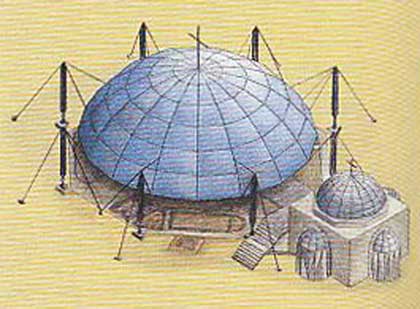4. Architectural Work  4.5 Holy Shrine of Kathisma
4.5 Holy Shrine of Kathisma
4.5 Holy Shrine of Kathisma
The octagonal shape of the Church of the Kathisma reflects the structural type of traditional centrally defined buildings, be it martyria or churches. The interesting thing about the Kathisma is that it was built in the mid-fifth century A.D., which makes it quite an avant-garde example of Christian ecclesiastical architecture. Judging by the ground-plans of the known Christian churches, the Kathisma seems to be the very first octagonal church. It is also a major sacred monument or holy place, according to the Orthodox theological definition formulated at the Seventh Oecumenical Council, concerning the Holy Places in Palestine. In other words, it is one of those sacred places where Christ walked or sat or appeared or touched or generally cast his shadow with the Mother of the God, and is therefore distinguished not only for its historical dimension and authenticity, but also for its sanctity, a distinctive characteristic of unique importance. These characteristics thus create a devotional and archaeological context that is consistent with both the Orthodox devotional tradition and contemporary international practice regarding the protection of monuments and cultural goods. In fact, this context combines two requirements, which, if they are to be met, demand both a sensitive awareness of historical memory and the Greek Orthodox monumental heritage, and the possibility of religious veneration steeped in the atmosphere of the Early Christian monument. In this respect, Prof. Lavas believed that the following considerations may help the Holy Fathers and the Patriarchate’s Technical Bureau to reach a decision about the development and the rehabilitation of the shrine. He noted that :
- The first task was to clean, conserve, consolidate and secure the structural and decorative material (foundation, remains of walls, mosaics and so on). A suitable framework of metal and reinforced glass, that has already been used for the sacred rock of the Calvary in the Church of the Resurrection in Jerusalem, could, suitably be adapted to this monument, cover and protect the precious treasures, while allowing them to be viewed and visited.
- The setting-up of an infrastructure to serve devotional needs (including an altar and a place where pilgrims may wait and move about) next to, but not directly upon, the archaeological monument turns one’s mind to the two aforementioned requirements which have to be fulfilled on the site of the Kathisma: 1. the need to preserve unscathed the material vehicle of historical Christian memory, while allowing visitors to view it easily and experience it and 2. the need to fulfil the desire of the faithful to pay homage on the same site as, and as close as possisble to, the remnants of the ancient church and the rock. This poses an architectural problem, which may be resolved as follows: both the archaeological monument with its protective cover already mentioned, and its function as a shrine and a place of worship, together with the importance and the size of the shrine which has been uncovered, call for the construction of a light, shell-like structure, with a meticulously designed symbolic architectural form, that will embrace both aspects-archaeological monuments and place of pilgrimage - so that visitors may participate in both ancient Early Christian memory and the modern devotional experience. Apart from serving practical needs, such as allowing people to enter, exit and walk around the monument, pay homage and light a candle, conduct ceremonies and so on, the construction of a new monumental architectural shell will also enhance the shrine’s prestige and its architectural mise en valeur, for its great importance means that it should dominate the area and interact with the nearby Greek Orthodox Monastery of the Prophet Elijah. Prof. Lavas proposed that this architectural idea be implemented by the construction of a church-shaped metal vault to protect the archaeological monument, and the erection nearby, and in direct interrelation with the ancient shrine, of a small new Orthodox church. Last, he proposed that the surrounding area be landscaped to serve the needs of visistors and pilgrims.
The Kathisma of the Holy Virgin has offered a unique opportunity to highlight Christian presence in the Holy Land in all its aspects: as a faith and tradition, as a guardian and servant of the Christian monuments and shrines, and as contemporary action and artistic brilliance. The fact that this archaeological discovery was made at the turn of the second millennium offers to the Patriarchate of Jerusalem, the Mother of Churches, a truly godsent opportunity to offer the Kathisma of the Mother of God to Christians everywhere, as the millennial treasure of the year of Our Lord 2000, made ready and administered by its perennial guardians, the monks of the Holy Sepulchre.





















